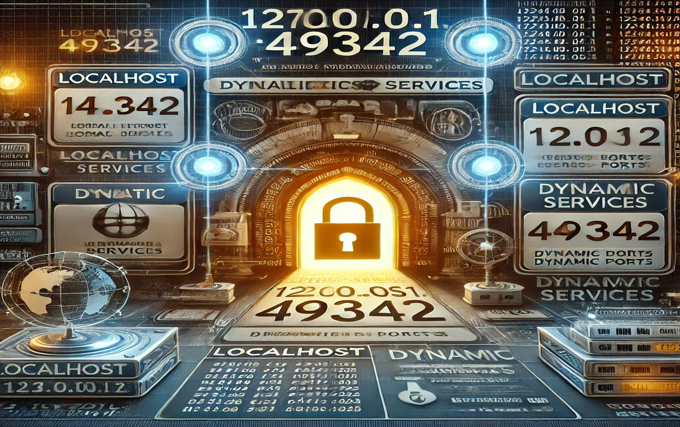The world of computer networking can seem daunting at first glance, especially when it comes to understanding the many nuances of IP addresses and ports. One of the most frequently encountered addresses in networking is 127.0.0.1, often referred to as “localhost.” But when you see it followed by 49342, it introduces a new layer of complexity. In this guide, we’ll dive deep into the meaning of 127.0.0.1:49342, explore the roles of localhost and ports, and discuss why this specific pairing might matter to you.
What is 127.0.0.1?
At its core, 127.0.0.1 is a loopback IP address. It’s essentially a way for your computer to refer to itself. When you use this IP address, you’re not reaching out to another machine on the network or internet; instead, you’re accessing services on your own device. Here’s a breakdown of what this address represents:
- IP Address 127.0.0.1: This is reserved for loopback functions, meaning it allows your computer to communicate with itself.
- Localhost: This is simply a hostname for 127.0.0.1. When you type “localhost” into your browser’s address bar, your computer interprets it as “127.0.0.1.”
- Self-Testing: Developers often use 127.0.0.1 to test programs or services running on their machine without affecting external devices or networks.
When you type 127.0.0.1 into a browser, it essentially means, “connect to the web services running on my own computer.”
The Role of Ports in Networking
While 127.0.0.1 is the IP address, 49342 is what’s known as a “port.” In computer networking, an IP address and a port number together define the specific service or application you’re trying to communicate with on a machine. Every IP address can support thousands of ports, with each one allowing different services to run concurrently without interference.
Key Points About Ports:
- Port Numbers: Range from 0 to 65535. Ports 0-1023 are well-known and reserved for system services (like HTTP on port 80 or HTTPS on port 443). Anything above 1024 is typically used for dynamic or private purposes.
- Purpose of Ports: Ports act like channels. While an IP address is like the destination, the port tells the machine which door (or application) to knock on.
- Dynamic Ports: Ports above 1024, like 49342, are dynamic or ephemeral, meaning they are usually assigned temporarily for the duration of a session or connection.
What Does 127.0.0.1:49342 Mean?
When you see 127.0.0.1:49342, you are combining two elements:
- 127.0.0.1 (localhost): Refers to your own computer.
- :49342: Refers to a specific port number where a service is running.
Thus, 127.0.0.1:49342 is telling your computer, “connect to the service that is running on port 49342 on this device.” The port number could be hosting a wide variety of services depending on what software you are using, ranging from web servers to gaming applications, or even custom software.
Common Uses of 127.0.0.1 and Dynamic Ports
Developers, IT professionals, and users who work with networked applications often see 127.0.0.1:49342 or similar combinations while developing, debugging, or hosting services locally. Here are some common examples where this pairing might come into play:
1. Local Web Development
- Many developers use localhost (127.0.0.1) to test web applications before deploying them live. Port numbers help them manage multiple projects simultaneously without conflict.
- For example, a web application might be accessible at 127.0.0.1:8000, while an API might be running at 127.0.0.1:49342.
2. Database Connections
- Databases like MySQL or MongoDB often run on localhost with specific ports assigned to them. You might see connections like 127.0.0.1:27017 for MongoDB.
- If a custom service connects to a database or API via 127.0.0.1:49342, it means that service is leveraging local resources, ensuring data never leaves your machine.
3. Game Servers
- Gamers or developers creating multiplayer games may run a local server on 127.0.0.1. The game itself could communicate via dynamic ports like 49342.
- This setup allows for testing multiplayer functionality on a local machine before rolling out updates to a public server.
4. Security Testing
- Cybersecurity experts often simulate attacks or test firewall rules on their local machine using 127.0.0.1 with different ports. By manipulating services hosted on various ports, they can assess vulnerabilities or test security measures without risking network exposure.
Troubleshooting Common Issues with 127.0.0.1:49342
While 127.0.0.1 is reliable, issues may arise, especially when dealing with dynamic ports. Here are some common problems and solutions:
1. Port Conflicts
- Problem: If two services try to use the same port (e.g., 49342), you’ll get an error or conflict.
- Solution: Identify the conflicting service and change its port to avoid the overlap. Most software allows you to specify a different port in its configuration file.
2. Firewall Restrictions
- Problem: Firewalls may block access to certain ports, even on localhost, preventing services from running as expected.
- Solution: Adjust firewall settings to allow traffic on specific ports. Ensure only trusted services are enabled to prevent potential security risks.
3. Service Not Responding
- Problem: A service on 127.0.0.1:49342 might fail to respond, often because the service is not running.
- Solution: Ensure that the application or service is active. Check logs and restart the service if necessary.
Conclusion
In conclusion, understanding 127.0.0.1:49342 is crucial for anyone working in IT, development, or network security. This combination of localhost and dynamic port usage allows services to run locally on your machine without external network interference. It’s commonly used in web development, gaming, database connections, and security testing. By learning how localhost interacts with ports, you can troubleshoot issues like port conflicts, service failures, or firewall restrictions. Mastering this concept enables you to better manage your local environment, ensuring smooth and efficient operation of various applications and services running on your computer.








